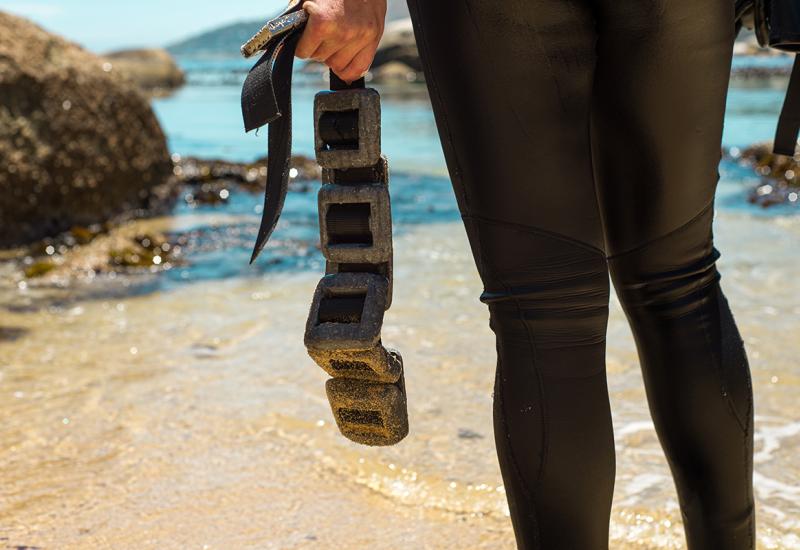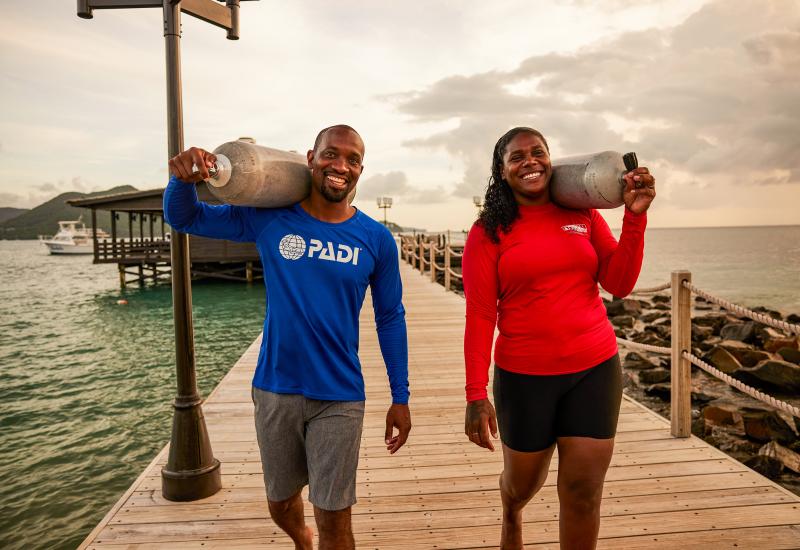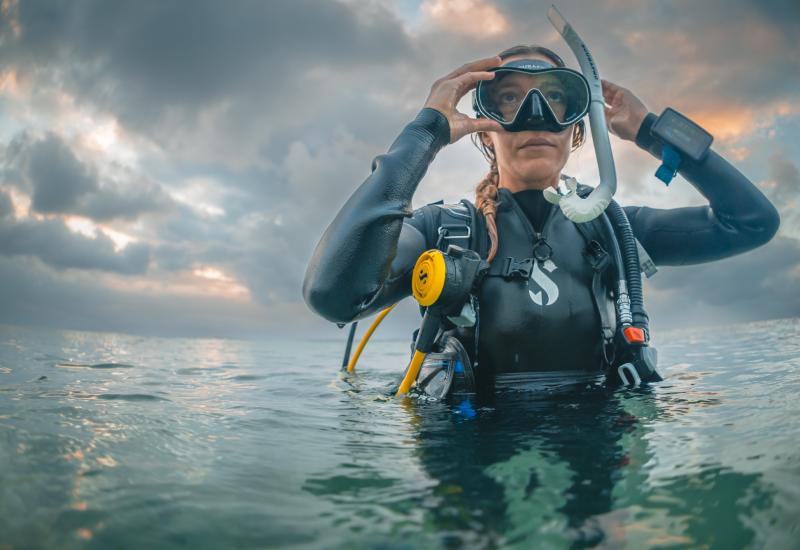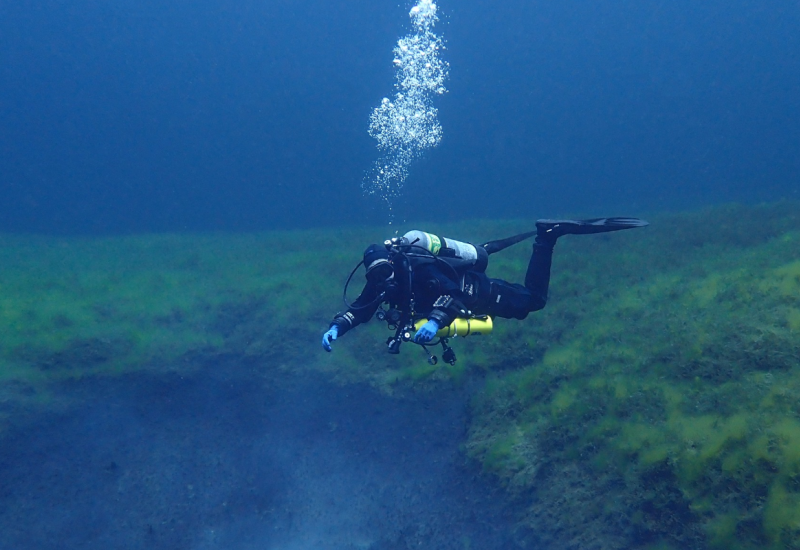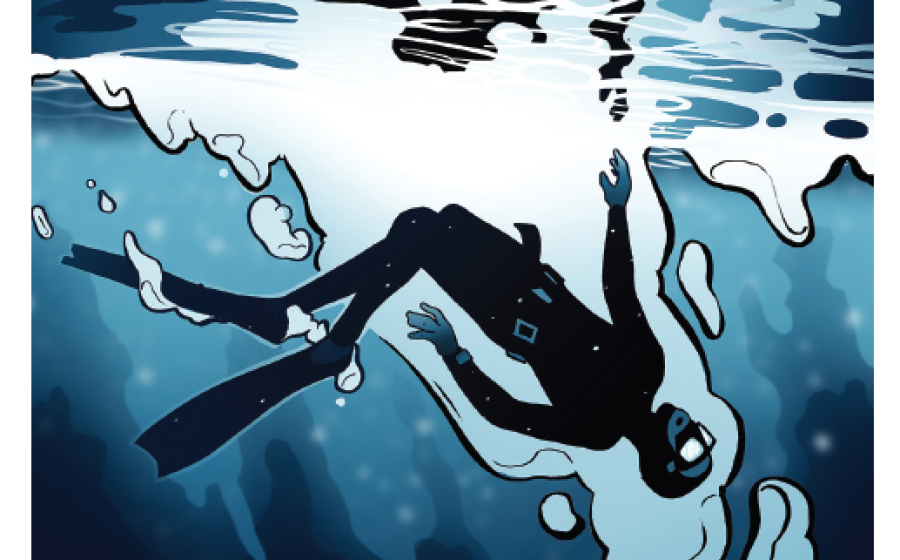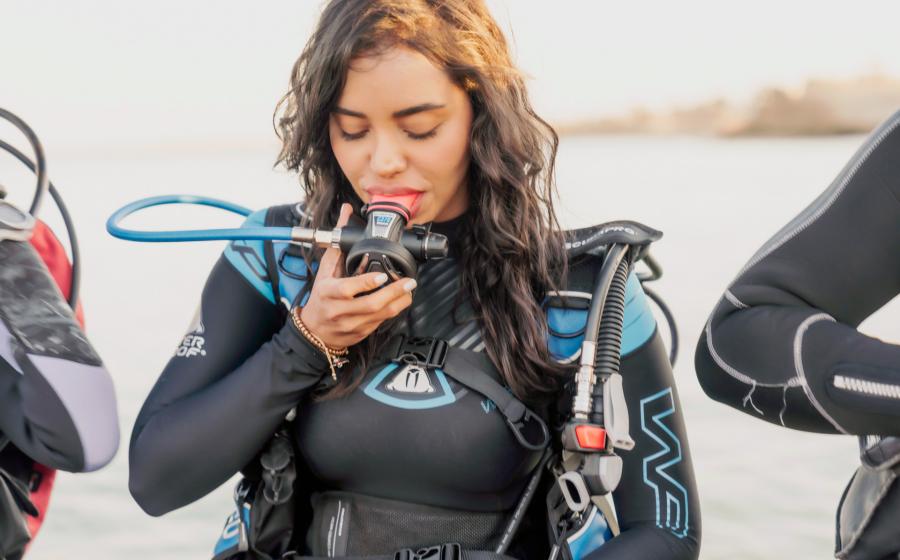Diving With the Kids
Diving with the Kids
I have often joked in my blog that diving with our three daughters is a bit like trying to herd kittens. And although this is a humorous exaggeration, the reality is that diving with the kids is both a great joy and a huge responsibility.
When my husband Dave and I first learned to dive, way back in 1994, our kids were still quite young. I looked on this new pastime as not only a new adventure and skill set, but as an escape from mommyhood, at least for short interludes. Our daughters, then aged 10, eight and two, knew that Mom and Dad were experiencing a life aquatic. They were intrigued by the stories we told of the cool things we saw underwater and the beautiful places we visited, and they watched us dive from the shore in several locations.
Growing up with an old concrete pool in the backyard, the girls were always very comfortable in water. Masks, snorkels and fins were everyday pool toys, along with sinking treasures to dive down to fetch off the bottom, and a flotilla of floating paddleboards, air mattresses and pool noodles. All of the kids became good swimmers, but they seemed more interested to spend their time in the pool under the water than on the surface of it.
In 2003, when our oldest was aged 18, she asked to learn to dive. We had a family vacation planned to Cuba - our first-ever family tropical vacation, and she wanted to be able to dive with us. The next oldest, then 16 and not yet expressing a desire to dive, would be left on the beach in charge of the little one while we were underwater. Dave and I had certified in cold water, and our eldest daughter planned to do this as well. She passed her course with flying colors, and on those first dives with the parental units in Cuba, she happily absorbed the mentoring we provided and quickly mastered buoyancy control and air consumption.
A few years later, the middle and youngest daughters also expressed a desire to get certified. The youngest, then 14, was only eligible to get her PADI Junior Certification. A year later, after turning 15, she was reissued a new card as a PADI Basic Open Water diver. The two younger daughters chose to do a PADI Referral certification – together, they did their classroom and pool work at home, and then they did their four referral certification dives with Christi of Blue XT-Sea Diving in beautiful Cozumel. Christi did an excellent job of introducing them to open ocean diving, and helping them to master their skills. She still tells the story of our youngest, who, on her first post-certification dive, had a major mask malfunction at depth (the lens fell right out of her mask and caused a massive flood!). Instead of panicking, as many inexperienced divers might do when faced with such a situation, she coolly swam up to her Dad and pointed out the problem. Our divemaster Arturo, tuned in to the situation, swapped out his mask for hers, and dove the rest of the dive wearing hers, holding the lens in place. Big tip for him that day!
And that brings me to the delicate question - when is a kid ready to dive? In our experience, we waited for them to express the desire, rather than our urging them on or creating an agenda that suited us and our travel plans. We also waited until they were both physically strong enough to handle the equipment and emotionally mature enough to handle difficult situations, which, even with careful planning and dive practices, can arise underwater.
Speaking from my own experience of raising three kids, children and teenagers can be emotionally volatile and overly (and sometimes inappropriately) reactive in stressful situations. Stress sometimes happens underwater – losing sight of buddy, currents, unwanted animal interactions, equipment malfunctions – and any of these can lead to panic. Panic can kill divers, leading them to make bad decisions (bolting to the surface being the most common, and the most lethal). So you need to know your kids have the maturity to stop, think and then act, even in stressful situations. They also need to be able to thoroughly understand the physics of diving, and to be constantly attentive to their depth, time and air consumption while they are underwater.
You also need to recognize that when you are buddy diving with your child, in addition to your responsibility for them, they are also responsible for you. Would your kid be able to keep it together and assist you with air donation, buoyancy compensator failure, medical emergency or other stressful event?
Since our three daughters have learned to dive, we have shared many hugely memorable adventures diving together, both as a family and on quite a few “mom and me” trips. There is great joy in seeing them become accomplished, confident divers, and the bonding experiences we’ve had diving as a family, and one on one, are, to all of us, irreplaceable.
Just don’t ask me to buddy with three kids on a night dive while I am trying to shoot pictures. Herding kittens, I tell you.
Judy G is an avid underwater photographer and traveler whose work has appeared in several dive publications. Judy also shares a comprehensive dive travel and photo blog.

Judy GYoungest daughter showing off her dance moves during a safety stop in Thailand.
Diving with the Kids
I have often joked in my blog that diving with our three daughters is a bit like trying to herd kittens. And although this is a humorous exaggeration, the reality is that diving with the kids is both a great joy and a huge responsibility.

Judy GMiddle daughter freediving down to visit her mom, who, as usual, was puttering about under the boat, looking for last minute photo ops. I was not her buddy on this dive – her boyfriend, himself a diver, came along on this family trip.
When my husband Dave and I first learned to dive, way back in 1994, our kids were still quite young. I looked on this new pastime as not only a new adventure and skill set, but as an escape from mommyhood, at least for short interludes. Our daughters, then aged 10, eight and two, knew that Mom and Dad were experiencing a life aquatic. They were intrigued by the stories we told of the cool things we saw underwater and the beautiful places we visited, and they watched us dive from the shore in several locations.

Judy GEldest daughter and I went on a road trip in California, and spent three days diving in the gorgeous Channel Islands.

Judy GYoungest daughter looking out over the spectacular beauty of the Phi Phi Islands in Thailand. This was a “mom and me” dive trip – we did a weeklong liveaboard in the Similan Islands and added on a few days of land-based diving in Phi Phi.
Growing up with an old concrete pool in the backyard, the girls were always very comfortable in water. Masks, snorkels and fins were everyday pool toys, along with sinking treasures to dive down to fetch off the bottom, and a flotilla of floating paddleboards, air mattresses and pool noodles. All of the kids became good swimmers, but they seemed more interested to spend their time in the pool under the water than on the surface of it.

Judy GYoungest daughter diving off a colorful wall in Fiji. We’ve found Fiji to be a great destination for family diving.
In 2003, when our oldest was aged 18, she asked to learn to dive. We had a family vacation planned to Cuba - our first-ever family tropical vacation, and she wanted to be able to dive with us. The next oldest, then 16 and not yet expressing a desire to dive, would be left on the beach in charge of the little one while we were underwater. Dave and I had certified in cold water, and our eldest daughter planned to do this as well. She passed her course with flying colors, and on those first dives with the parental units in Cuba, she happily absorbed the mentoring we provided and quickly mastered buoyancy control and air consumption.

Judy GThis is my eldest daughter on an early family trip to Cuba. She was keen to try out my old point and shoot camera, and figured it all out a lot more quickly than her mama did.
A few years later, the middle and youngest daughters also expressed a desire to get certified. The youngest, then 14, was only eligible to get her PADI Junior Certification. A year later, after turning 15, she was reissued a new card as a PADI Basic Open Water diver. The two younger daughters chose to do a PADI Referral certification – together, they did their classroom and pool work at home, and then they did their four referral certification dives with Christi of Blue XT-Sea Diving in beautiful Cozumel. Christi did an excellent job of introducing them to open ocean diving, and helping them to master their skills. She still tells the story of our youngest, who, on her first post-certification dive, had a major mask malfunction at depth (the lens fell right out of her mask and caused a massive flood!). Instead of panicking, as many inexperienced divers might do when faced with such a situation, she coolly swam up to her Dad and pointed out the problem. Our divemaster Arturo, tuned in to the situation, swapped out his mask for hers, and dove the rest of the dive wearing hers, holding the lens in place. Big tip for him that day!

Judy GMiddle and youngest on a recent trip to Fiji. This image was captured at the infamous E6 dive site.
And that brings me to the delicate question - when is a kid ready to dive? In our experience, we waited for them to express the desire, rather than our urging them on or creating an agenda that suited us and our travel plans. We also waited until they were both physically strong enough to handle the equipment and emotionally mature enough to handle difficult situations, which, even with careful planning and dive practices, can arise underwater.

Judy GThis is our middle daughter diving in Thailand on a family trip a few years back. Thailand is another great family destination. Note the safety equipment – all of our family members carry a folding flag for signaling on the surface. These clever and inexpensive units can be seen from a long distance and are easy to stow in a BC pocket, or clipped off on a D ring. We also all carry a flashlight and a dive sausage that can be launched from the safety stop. This is essential gear, especially when diving in areas like Thailand, where there is a lot of boat traffic that can make surfacing risky.
Speaking from my own experience of raising three kids, children and teenagers can be emotionally volatile and overly (and sometimes inappropriately) reactive in stressful situations. Stress sometimes happens underwater – losing sight of buddy, currents, unwanted animal interactions, equipment malfunctions – and any of these can lead to panic. Panic can kill divers, leading them to make bad decisions (bolting to the surface being the most common, and the most lethal). So you need to know your kids have the maturity to stop, think and then act, even in stressful situations. They also need to be able to thoroughly understand the physics of diving, and to be constantly attentive to their depth, time and air consumption while they are underwater.

Judy GEldest daughter, totally wowed by a massive swarm of cownose rays in Costa Rica. We did a “mom and me” backpacking trip around the western part of the country several years ago and managed to squeeze in one day of diving at Catalina Island, using rental gear. This is not the best image I’ve taken (I had only brought along a little point and shoot as I needed to travel light), but this dive stands out as one of the most memorable in my diving history. There had to be several thousand rays in the school – when they passed over us, they almost completely blocked the light. Truly spectacular.
You also need to recognize that when you are buddy diving with your child, in addition to your responsibility for them, they are also responsible for you. Would your kid be able to keep it together and assist you with air donation, buoyancy compensator failure, medical emergency or other stressful event?
Since our three daughters have learned to dive, we have shared many hugely memorable adventures diving together, both as a family and on quite a few “mom and me” trips. There is great joy in seeing them become accomplished, confident divers, and the bonding experiences we’ve had diving as a family, and one on one, are, to all of us, irreplaceable.

Pablo PedroSadly, this is the only picture we’ve got of our family diving together. The photo credit goes to Pablo Pedro of Blue XT-Sea Diving. This image was taken on the trip when our middle and youngest daughters were certified, and this was the beginning of a really wonderful chapter in our family life. Now that the girls are all grown up and launched in the world, the opportunities to dive all together as a family are few and far between.
Just don’t ask me to buddy with three kids on a night dive while I am trying to shoot pictures. Herding kittens, I tell you.
Judy G is an avid underwater photographer and traveler whose work has appeared in several dive publications. Judy also shares a comprehensive dive travel and photo blog.

